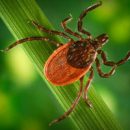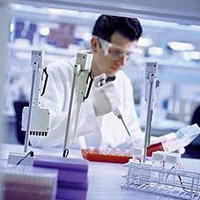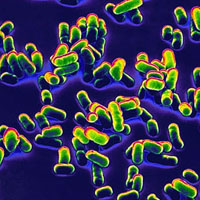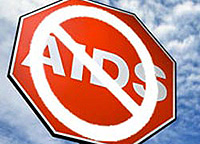Staphylococcal infection in children is a large group of purulent-inflammatory skin diseases, as well as diseases of the mucous and internal organs. Staphylococcus infection in children whose symptoms are characterized by a significant variety, arises and develops with weakened immunite.
Content
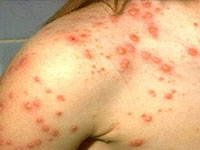 The causes of staphylococcal infection in children may have contacts with contaminated objects of life and everybody, as well as with patients or bacteria carriers. Infection quite often happens in breast children through maternal hands infected with golden staphylococcus, milk in case of cracks of a nipple or mastitis, milk mixtures, and through medical staff by violating sanitary and hygienic standards of care in hospital. The source of infection is the sick and carriers of pathogenic strains. According to statistical data, almost 1/5 of the population, herself is not suspected, is a permanent carrier of staphylococcus golden, one of the most dangerous microbes of this infectious family. Finding into the body of the kids, the microbe can cause different clinical manifestations — From the staphylococcal infection of the skin in children up to the damage of the bone marrow, the nervous system and internal organs. The severity and variant of staphylococcal infection in children, the symptoms of which can be purulent skin foci, rash, disorder and pain in the gastrointestinal tract, flatulence, diseases of the lungs and bronchi depend on the intensity of the inflammatory process, which is very dangerous in the first month of life of the baby, very vulnerable Before bacteria.
The causes of staphylococcal infection in children may have contacts with contaminated objects of life and everybody, as well as with patients or bacteria carriers. Infection quite often happens in breast children through maternal hands infected with golden staphylococcus, milk in case of cracks of a nipple or mastitis, milk mixtures, and through medical staff by violating sanitary and hygienic standards of care in hospital. The source of infection is the sick and carriers of pathogenic strains. According to statistical data, almost 1/5 of the population, herself is not suspected, is a permanent carrier of staphylococcus golden, one of the most dangerous microbes of this infectious family. Finding into the body of the kids, the microbe can cause different clinical manifestations — From the staphylococcal infection of the skin in children up to the damage of the bone marrow, the nervous system and internal organs. The severity and variant of staphylococcal infection in children, the symptoms of which can be purulent skin foci, rash, disorder and pain in the gastrointestinal tract, flatulence, diseases of the lungs and bronchi depend on the intensity of the inflammatory process, which is very dangerous in the first month of life of the baby, very vulnerable Before bacteria.
Risk factors include the pathological course of pregnancy and anomaly of the generic activity. Pregnant women, staphylococcal infection can be located on mucous throats, nasopharynx, in the intestine and in the vagina. This microorganism can cause a variety of clinical picture in children, so parents should be as attentive and in the manifestation of any signs, especially in the first months of the newborn life, immediately contact the pediatrician.
Staphylococcus skin infection in children: parents, be vigilant!
The classification of staphylococcal infection divides the disease to a localized and generalized option. It is more commonly found a localized form at which there is a damage to the skin or mucous membranes, for example, rhinitis, noodopaling. Skin bacterial infection in children is manifested by guns, abscesses and signs of piedermia, in newborns — This is a bubble and exfoliative dermatitis, followed by the reaction from local lymph nodes in the form of lymphadenitis, lymphangitis. This form proceeds without pronounced intoxication of the body with the absence of secondary inflammatory foci, with the manifestations of small subfebrylitetitis and insignificant changes in the blood. Breast kids marked bad appetite and lack of weight gain. In the case of the detection of purulent diseases of soft tissues and epithelial covers, it is Staphylococcus that is the main causative agent, which significantly aggregates the flow of burns and dermatitis. Localized version of staphylococcal infection, as well as some erased forms that are hardly diagnosed, represent a serious danger to the baby and require treatment.
Staphylococcal infection in children often tends to generalize the process, with a large share of the probability of sepsis and respiratory tract. Pneumonia due to staphylococcus usually proceeds in association with intestinal and blue rod, streptococcus. The pulmonary form of staphylococcal infection wears a speed and leads to serious destruction of the pulmonary fabric. For primary staphylococcal infection, one-sided localization of pneumonia is characterized, the development of secondary inflammation of the lungs occurs due to the propagation of purulent infection in the body and is often combined with conjunctivitis, otitis, osteomyelitis, piederma. Fast growing intoxication is noted in children of the first 6 months of life, for example, staphylococcal meningitis takes place very hard during this period of life of the baby and is a greater danger, as well as septic endocarditis.
Treatment of staphylococcal infection with localized forms is local antibacterial therapy. Heavy and medigative current requires comprehensive therapy, including antibiotics of penicillin rows, vitamins, enzymes, probiotics and immunogenesis stimulants.


